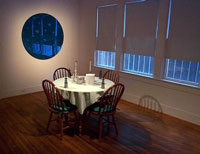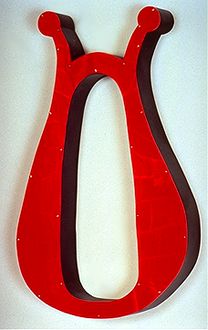James Gallery, like several other Houston galleries, is a house converted into exhibition space. Cropduster cleverly puns the space’s former identity, playing with the subtle distinction between sculptural objects and their “real world” counterparts.
Chris Sauter‘s large scale works are all based on pieces of furniture, and occupy the gallery space in the same way that real furniture would have: loveseat and coffee table in the living room, table and chairs in the dining room, and recliner in the TV room. Complementing Sauter’s furniture, Hills Snyder‘s pieces play the role of decor, hanging on walls or hidden in odd corners.
Sauter’s Factory: Mauna Loa Loveseat takes an ordinary upholstered couch and remakes it into a stunningly crafted three-dimensional contour map. Rising from the loveseat’s single cushion is an asymmetrical mound pitted by minuscule craters. The authority of Sauter’s craftsmanship makes it easy to believe the mountain is indeed an exact scale model. The entire piece is upholstered in fabric printed with quaint shepherds, milkmaids, and farm carts that sprawl every which way across the sofa, their absurdity reaching its climax as these images crawl up the sides of the volcanic slope. The companion piece, Factory: Kilauea Coffee Table is carved wood. Starting with low rectangular table, Sauter has built up layers of pine, grinding them into the contours of the famous volcano and covering the entire project with a syrupy varnish that recalls roadside chainsaw sculpture.

Interior of the gallery withHills Snyder’s Sputnik (on wall), 2001,and Chris Sauter’s Refinery, 2000
Sauter’s Refinery, in the dining room space, is based on a round kitchen table and four ordinary chairs. In the center of the table, an intricate scale model of oil refining equipment sits atop a green checked tablecloth that is strikingly effective at suggesting an Oklahoma prairie. At each of the table’s four places, a miniature derrick sinks a tiny shaft down through the tabletop and into the green cushion on the chair seat below, as if extracting some natural resource and pumping it to the center of the table for processing.
Sauter’s inventive formal transformations reduce vast landscapes to living room size. In Leaf a table leaf is transformed into an orchard of tiny trees; with characteristic attention to detail, Sauter has extended his joke by making wiry roots that stick out from the bottom. Here Sauter’s visual/verbal punning is uncluttered. Other works reach for a metaphoric relationship between the two geographies which never quite clicks: Refinery‘s contrast of bland suburban furniture with an industrial installation could be a comment on food contamination, life in middle America, or farting, but it isn’t especially precise or evocative. Likewise, his Hawaiian volcano pieces begin comparisons between a living room and the Pacific Ocean, between a familiar domestic environment and an exotic natural one, but don’t follow through.
Witty and succinct, Hills Snyder‘s best works pack a double whammy: one enjoys their slick, brightly colored shapes only to be caught on the rebound by their crisply articulated psychological implications. In Fortune Hunter, the silhouette of a shotgun in black Plexiglas bends absurdly around the corner of a doorframe with a liquid flexibility, as if melting. Thus rendered harmless, the gun becomes more silly than sinister. In Guilt, an odd biomorphic shape in red acrylic turns out to be a horse collar, neatly equating the mental burden of guilt with the physical load pulled by a carthorse, each borne with a similar resignation. Mixed in are a few also-rans like Sputnik, Coda, and My Cup Runneth Over, which are overshadowed by Snyder’s best pieces. Blood of the Lamb That Bit You is heavy handed (superimposing a smiley face on a cross is a little too much).
Quiet but compelling, the best piece in the show is Lies and Whispers, a pair of life-sized single-bladed axes cut from thick sheets of transparent acrylic. Leaning against the dining room wall they have a crystalline fragility strongly at odds with their rugged imagery. One is rosy pink, one icy blue, suggesting a gender relationship that is anything but peaceful. His and Hers axes. Yet the lightness and jewel-like beauty of the material suggests a psychic rather than a physical conflict.
Fringe, Fact Finding Mission, and Manifest indulge in cultural critique with a gentle irony and a faint pseudo-subversive naughtiness. Over the gallery entrance hangs Fringe, a row of pine-shaped air fresheners that waft a faint odor of artificial vanilla into the gallery space. Incongruously printed with stars and stripes, the little trees make a schizophrenic attempt to be odorless and patriotic at the same time. Snyder’s humorous critique of American jingoism is carried out on an even more stealthy level in Manifest, a skin of fluorescent pink vinyl stretched across the back wall of the TV room like the hide of some swollen guinea pig, until one realizes that it is in fact the contour of the southern border of the United States, mirrored as if in an inkblot.
Bill Davenport is an artist and writer and was the first contributor to Glasstire. Since 2008 he has served as Glassstire’s News & Events Editor.





1 comment
Alright Hills love this one too!!!